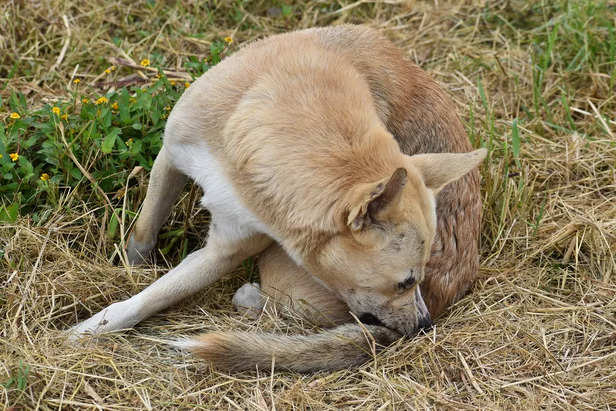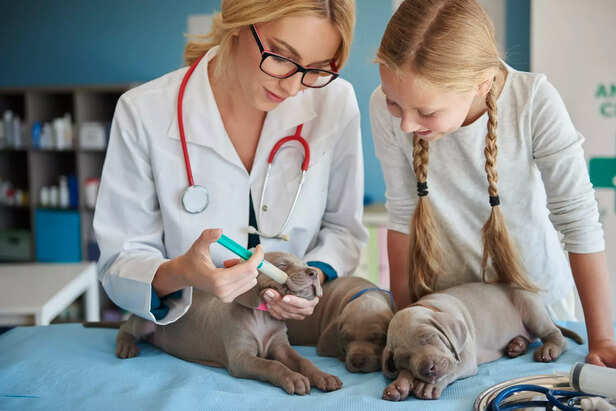Top Signs Your Pet Needs a Vet Visit
Nikita Kanyal | Nov 10, 2024, 20:14 IST
Signs your pet needs a vet visit (Image Source : Pixabay)
To keep our pets healthy and content, we must be vigilant for subtle indications of illness, since they cannot communicate discomfort as we do. Crucial indicators consist of modifications in eating or drinking patterns, fatigue, strange bathroom habits, swift weight fluctuations, excessive grooming, breathing difficulties, altered behavior, observable pain, irregular swelling or discharge, and dental issues. Routine veterinary check-ups are essential for early identification, especially for senior pets. Biannual check-ups assist in identifying possible problems, resulting in faster, more efficient treatments and improved overall health for our animal companions.
As pet owners, we understand that our beloved animals can't express themselves when they're unwell. We need to be mindful of the signs that might indicate they need a visit to the veterinarian. Some of these signs may be quite subtle, but being attentive can significantly improve our pets' overall happiness and health.
1. Changes in Eating or Drinking Patterns
A sudden change in your pet's eating or drinking habits may signify an important early alert of potential health problems.
Decreased Appetite: Typically, cats and dogs have a robust inclination to eat unless a problem arises. A drop in their appetite may suggest dental problems, digestive issues, infections, or more serious ailments like kidney disease or cancer.
Enhanced Thirst: While a slight rise in water consumption may occur in hotter climates, persistent thirst may indicate possible health problems such as diabetes, kidney issues, or liver complications.
When to Go to the Vet: If you observe any strange alterations in your pet’s eating or drinking patterns that persist for more than a day or two, it’s wise to arrange a vet visit for additional assessment.

Just like humans, pets can have off days when they’re less energetic. However, ongoing lethargy and tiredness could point to something more serious.
Lethargy: This is usually one of the first signs that something might be wrong with your pet. If your buddy seems unusually tired, doesn’t want to get up, or isn’t interested in playing or going for walks, it could indicate infections, anemia, heart issues, or other health problems.
When to Visit the Vet: If your pet continues to seem lethargic after a day, it’s wise to take them to the vet, particularly if this behavior is unusual for them.
Watching your pet's bathroom behaviors can offer important clues about their internal health.
Urinary Problems: Trouble with urination, presence of blood in urine, or frequent urges to urinate may suggest urinary tract infections (UTIs), kidney problems, or bladder stones.
Digestive Issues: Symptoms such as vomiting, diarrhea, constipation, or alterations in stool color and texture may indicate infections, dietary concerns, or gastrointestinal disorders.
Digestive Issues: Vomiting, diarrhea, constipation, or alterations in stool color and texture may indicate infections, dietary concerns, or gastrointestinal disorders.
When to Visit the Vet: If digestive problems continue for over 24 hours or if you notice blood in their urine or feces, contact your veterinarian.
Sudden weight changes are often a red flag for underlying health issues. Weight Reduction: Sudden weight reduction in your pet may signal parasites, kidney problems, cancer, or diabetes, especially if they are still eating normally , Having them checked is a smart decision.
Weight Gain: udden rise in weight could signal issues like hypothyroidism, fluid retention (possibly linked to heart disease), or various metabolic disorders.
When to Visit the Vet: Any sudden or unexplained weight changes should be assessed by a veterinarian, as early treatment can significantly improve the prognosis

While occasional scratching is normal, excessive itching, licking, or biting of the skin is not.
Allergies: Pets can develop allergies to foods, plants, or other environmental factors, leading to skin irritation and itching.
Parasites: Fleas, ticks, and mites can cause severe itching and discomfort.
Skin Infections: Pets with skin infections may scratch intensely, resulting in red, inflamed, or scabby skin.
When to Visit the Vet: If you observe hairless areas, lesions, or constant itching, it's advisable to seek your vet's advice for diagnosis and care.
Respiratory symptoms, particularly if they continue, may indicate an infection or other serious ailments.
Coughing: A continual cough could signify kennel cough, heartworm, or possibly heart disease.
Sneezing: Rare sneezing is typical, but persistent sneezing with discharge may indicate an upper respiratory infection.
Difficulty Breathing: Signs of respiratory distress or wheezing could be critical and require immediate attention.
When to See the Veterinarian: If your pet often coughs, sneezes, or has difficulty breathing, visiting the vet is crucial.

Sudden shifts in behavior are often a pet’s way of indicating pain or discomfort.
Aggression: If your usually friendly pet suddenly turns aggressive, it might mean they’re in pain.
Withdrawal: When your pet starts hiding or keeping to themselves a lot, it could be a sign of illness or stress.
Anxiety: If you notice your pet is more anxious or restless than usual, they might be feeling uncomfortable or in pain.
When to See the Vet: If your pet shows any strange behavior, especially aggression or hiding, it’s a good idea to take them to the vet.
Pets might not always express pain through sounds, but there are signs to indicate if they are in distress.
Limping: A limp may indicate an injury, arthritis, or various joint issues.
Postural Adjustments: A curved spine, stiff motions, or a slouched position frequently indicate your pet is experiencing pain.
Whining or Yelping: Numerous pets convey their discomfort through vocalizations, especially when they are handled or shifted.
When to Visit the Veterinarian: If you observe any indications of discomfort in your pet, particularly if there are noticeable alterations in their physical state, it’s advisable to seek veterinary advice.

Swelling or discharge in any part of the body can be a sign of infection, injury, or other medical conditions.
Eye Discharge: Red, swollen eyes with discharge could indicate an eye infection, allergies, or even glaucoma.
Ear Discharge: Smelly, waxy, or unusual ear discharge may be a sign of an ear infection.
Swelling: Any lump, bump, or swelling on your pet’s body should be evaluated.
When to See the Vet: Any unusual discharge, especially with redness or swelling, warrants a vet’s attention.
Oral health is essential for pets, and foul breath frequently indicates dental problems
Halitosis: Persistent bad breath may signal dental issues or infections.
Swollen Gums or Loose Teeth: Conditions such as gum disease or tooth decay can cause discomfort and might result in additional health problems if left untreated.
When to See the Vet: Routine dental examinations are vital, but if you observe strange breath or any signs of pain while eating, it's wise to seek advice from a vet.

Routine veterinary examinations are essential for detecting health issues early, which can result in simpler and typically more effective treatments. Veterinarians typically advise yearly wellness check-ups for younger animals and biannual visits for older pets. These regular check-ups enable veterinarians to monitor your pet's health, assess weight, and promptly identify any emerging health concerns.
1. Changes in Eating or Drinking Patterns
A sudden change in your pet's eating or drinking habits may signify an important early alert of potential health problems.
Decreased Appetite: Typically, cats and dogs have a robust inclination to eat unless a problem arises. A drop in their appetite may suggest dental problems, digestive issues, infections, or more serious ailments like kidney disease or cancer.
Enhanced Thirst: While a slight rise in water consumption may occur in hotter climates, persistent thirst may indicate possible health problems such as diabetes, kidney issues, or liver complications.
When to Go to the Vet: If you observe any strange alterations in your pet’s eating or drinking patterns that persist for more than a day or two, it’s wise to arrange a vet visit for additional assessment.
2. Lethargy and Tiredness

(Image Source : Pixabay)
Just like humans, pets can have off days when they’re less energetic. However, ongoing lethargy and tiredness could point to something more serious.
Lethargy: This is usually one of the first signs that something might be wrong with your pet. If your buddy seems unusually tired, doesn’t want to get up, or isn’t interested in playing or going for walks, it could indicate infections, anemia, heart issues, or other health problems.
When to Visit the Vet: If your pet continues to seem lethargic after a day, it’s wise to take them to the vet, particularly if this behavior is unusual for them.
3. Changes in Bathroom Habits
Urinary Problems: Trouble with urination, presence of blood in urine, or frequent urges to urinate may suggest urinary tract infections (UTIs), kidney problems, or bladder stones.
Digestive Issues: Symptoms such as vomiting, diarrhea, constipation, or alterations in stool color and texture may indicate infections, dietary concerns, or gastrointestinal disorders.
Digestive Issues: Vomiting, diarrhea, constipation, or alterations in stool color and texture may indicate infections, dietary concerns, or gastrointestinal disorders.
When to Visit the Vet: If digestive problems continue for over 24 hours or if you notice blood in their urine or feces, contact your veterinarian.
4. Unexplained Weight Loss or Gain
Weight Gain: udden rise in weight could signal issues like hypothyroidism, fluid retention (possibly linked to heart disease), or various metabolic disorders.
When to Visit the Vet: Any sudden or unexplained weight changes should be assessed by a veterinarian, as early treatment can significantly improve the prognosis
5. Excessive Scratching or Grooming

Can be a response to orthopedic problems (Image Source : Freepik)
While occasional scratching is normal, excessive itching, licking, or biting of the skin is not.
Allergies: Pets can develop allergies to foods, plants, or other environmental factors, leading to skin irritation and itching.
Parasites: Fleas, ticks, and mites can cause severe itching and discomfort.
Skin Infections: Pets with skin infections may scratch intensely, resulting in red, inflamed, or scabby skin.
When to Visit the Vet: If you observe hairless areas, lesions, or constant itching, it's advisable to seek your vet's advice for diagnosis and care.
6. Coughing, Sneezing, or Breathing Issues
Coughing: A continual cough could signify kennel cough, heartworm, or possibly heart disease.
Sneezing: Rare sneezing is typical, but persistent sneezing with discharge may indicate an upper respiratory infection.
Difficulty Breathing: Signs of respiratory distress or wheezing could be critical and require immediate attention.
When to See the Veterinarian: If your pet often coughs, sneezes, or has difficulty breathing, visiting the vet is crucial.
7. Changes in Behavior or Temperament

Change in Behaviour (Image Source : Pixabay)
Sudden shifts in behavior are often a pet’s way of indicating pain or discomfort.
Aggression: If your usually friendly pet suddenly turns aggressive, it might mean they’re in pain.
Withdrawal: When your pet starts hiding or keeping to themselves a lot, it could be a sign of illness or stress.
Anxiety: If you notice your pet is more anxious or restless than usual, they might be feeling uncomfortable or in pain.
When to See the Vet: If your pet shows any strange behavior, especially aggression or hiding, it’s a good idea to take them to the vet.
8. Visible Signs of Pain
Limping: A limp may indicate an injury, arthritis, or various joint issues.
Postural Adjustments: A curved spine, stiff motions, or a slouched position frequently indicate your pet is experiencing pain.
Whining or Yelping: Numerous pets convey their discomfort through vocalizations, especially when they are handled or shifted.
When to Visit the Veterinarian: If you observe any indications of discomfort in your pet, particularly if there are noticeable alterations in their physical state, it’s advisable to seek veterinary advice.
9. Discharge or Swelling

May result from various stimuli (Image Source : Pixabay)
Swelling or discharge in any part of the body can be a sign of infection, injury, or other medical conditions.
Eye Discharge: Red, swollen eyes with discharge could indicate an eye infection, allergies, or even glaucoma.
Ear Discharge: Smelly, waxy, or unusual ear discharge may be a sign of an ear infection.
Swelling: Any lump, bump, or swelling on your pet’s body should be evaluated.
When to See the Vet: Any unusual discharge, especially with redness or swelling, warrants a vet’s attention.
10. Bad Breath or Dental Issues
Halitosis: Persistent bad breath may signal dental issues or infections.
Swollen Gums or Loose Teeth: Conditions such as gum disease or tooth decay can cause discomfort and might result in additional health problems if left untreated.
When to See the Vet: Routine dental examinations are vital, but if you observe strange breath or any signs of pain while eating, it's wise to seek advice from a vet.
Why Regular Vet Visits are Important

Vets visits
Routine veterinary examinations are essential for detecting health issues early, which can result in simpler and typically more effective treatments. Veterinarians typically advise yearly wellness check-ups for younger animals and biannual visits for older pets. These regular check-ups enable veterinarians to monitor your pet's health, assess weight, and promptly identify any emerging health concerns.
